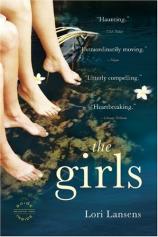The Girls
Review
The Girls
Meet Rose and Ruby Darlen. They're a lot like other sisters you might know. They squabble over petty jealousies and larger differences of opinion. They can be each other's best friends and worst enemies. They've lived in the countryside outside a small, rural Canadian town for almost their entire lives. Both young women work at the local library (Rose shelves books and Ruby conducts a story hour for the children's department). Like all sisters, they wage a constant battle between the desire to be close and the desire to be independent.
But, in Ruby and Rose's case, the desire to be truly independent is more symbolic than literal, and their closeness is so essential to their very existence that it's almost impossible for the rest of us to imagine. In fact, "The Girls," as the residents of their small town have dubbed them, have never been apart for even a moment of their 29 years. You see, Rose and Ruby are conjoined twins, craniopagus (joined at the head) twins who share their blood supply as well as their skull bone.
Because of the orientation of their conjoined heads, Rose and Ruby have never actually seen each other's faces, except in a mirror, as Rose explains in the book's opening paragraph: "I have never looked into my sister's eyes. I have never bathed alone. I have never stood in the grass at night and raised my arms to a beguiling moon. I've never used an airplane bathroom. Or worn a hat. Or been kissed like that. I've never driven a car. Or slept through the night. Never a private talk. Or solo walk. I've never climbed a tree. Or faded into a crowd. So many things I've never done, but oh, how I've been loved. And, if such things were to be, I'd live a thousand lives as me, to be loved so exponentially."
As might be gleaned from this opening bit of narration, Rose fancies herself as a writer. It's her idea to write her autobiography, and she brings Ruby along as an (initially) reluctant participant. Rose has always been the stronger of the two girls, both physically (she has actually carried the clubfooted Ruby on her hip since the two girls were toddlers) and emotionally. But now, on the eve of their 30th birthday, Rose is facing her own crisis that prompts her to write the story of her life and gives a certain urgency to the narrative.
What is perhaps most remarkable about this, Lori Lansens's second novel, is that Lansens not only successfully humanizes these characters, she does so in a way that underscores their dependence on one another (both literally and figuratively) as well as their individuality. Rose loves watching sports, reading and writing. Her face is distorted, while Ruby's is (by all accounts) lovely. Ruby herself is fascinated by Native artifacts, particularly those she finds on the sisters' careful walks through their adoptive parents' farm fields.
In the two women's narratives, the sisters further underscore their differences. The passages, which were set in different typefaces, didn't really need such a dramatic treatment in order for readers to differentiate the sisters' voices. Rose, the writer, crafts her life story carefully, starting (more or less) from the beginning and focusing on the past almost exclusively. Her narrative, while descriptive and precise, seems to lack emotion, as if Rose is purposefully distancing herself from the events of her life. Ruby, on the other hand, is spontaneous and effusive, eagerly looking forward to the surprise birthday party she's planning for Rose and candidly reflecting on what might come afterward. Throughout the book, Lansens carries the conceit that the two sisters are writing their sections of the autobiography independently, without consulting the other. The result is a lot of assumptions --- "I imagine Rose has already said it all" --- many of which are wrong, illustrating that the sisters might not know each other so well after all.
If at times THE GIRLS seems to lack a dramatic, overarching plot, that's because it is structured like an autobiography and because it is, in the end, much more about character than about story. It is noteworthy for these unusual and tightly drawn character studies, as well as for the clever way Lansens chooses to tell The Girls' story. Far from seeming ridiculous or gimmicky, THE GIRLS manages to care deeply about its subjects --- and to get readers to care about them, too.
Reviewed by Norah Piehl on April 10, 2007
The Girls
- Publication Date: April 10, 2007
- Genres: Fiction
- Paperback: 346 pages
- Publisher: Back Bay Books
- ISBN-10: 0316066346
- ISBN-13: 9780316066341




